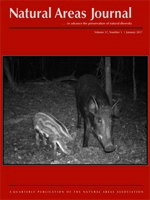Israel Moreno-Contreras, Héctor Gómez de Silva, Javier Cruz-Nieto, Jesús Ordaz-Morales, Alejandro Botello
Natural Areas Journal 37 (1), 69-85, (1 January 2017) https://doi.org/10.3375/043.037.0110
KEYWORDS: biodiversity surrogates, Chihuahua, ecological complementarity, effectiveness, representativeness, taxonomic distinctness
Earth's ecosystems and biodiversity have been heavily impacted by anthropogenic activities, with land use change being the most important factor in terrestrial environments. One of the most important strategies for preserving biodiversity has been the establishment of protected areas. The reserve network of Chihuahua, Mexico's largest state, was first established in 1939 and currently includes 13 protected areas. The effectiveness of this conservation network to represent species, populations, and habitats has not been evaluated. We assess Chihuahuan protected areas with regard to the avifauna by evaluating ecological, geographical, and phylogenetic data. We compiled records from published literature, curatorial databases, reports, and recent field work to determine the species present in the reserves and to evaluate taxonomic distinctness. Index of taxonomic distinctness helps identify areas that have similar or identical species richness. We gathered data representing bird distributions, vegetation types, ecoregions, physiographical provinces, and priority areas to identify those species and ecosystems underrepresented or poorly represented in the current conservation network. We found that 98.3% of all bird species in Chihuahua are represented in protected areas, but important hotspots of species richness (containing 288–290 and 300 species), protected species (39–42 species), restricted-range species, and quasiendemic species (11 species) are poorly represented. Twelve vegetation communities and seven physiographical provinces are little represented. Ecoregion representativeness is relatively good and Chihuahua´s bird conservation areas are fairly well represented. We propose sites where new protected areas can be useful and can have the largest impact on bird conservation, particularly for those poorly represented species, hotspots, or ecosystems.

